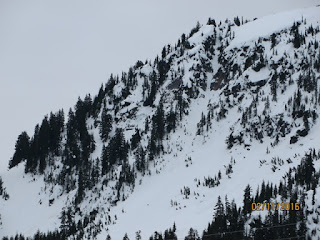Q: So Dan, what do you do when it's not snowing and we're not doing control work?
A: I ski around and take pictures of all the avalanches that are happening.
It's been really interesting to watch the transition from dry avalanche problems to loose wet, to glide/wet slab. If you remember, we had some dry spells in January but it was never very warm. The second half of January brought a few control days, and then we had our first real rain event (>.25 water) since December 9 on January 26-27. The rain on snow caused several wet-loose avalanches around the ski area, but the main result was the natural off the steep rock slab in Tye Stick that happened after a 3 degree rise in temperature in one hour at 1:00pm on the 27th. This is the one the Fernie guys called in (click on all images to enlarge).
After that it cooled down and we got 11" of snow on the 30th, then it went cold and dry to start February. We got another 12" of snow (1.08" SWE) between February 4-6 and then on the 7th freezing levels climbed to Pass level. By the 8th, the high temp at Skyline was 45 degrees, then hit a high of 57 degrees (!!!) on the 9th. East flow at pass level created temperature differences of up to 18 degrees between Tyemill and Skyline. Temperatures were closer to freezing at Schmidt Haus and Tyemill, but overall stayed above 32 for 3 straight days. During that time the following glide cracks/wet slabs either slid or began to creep.
Top of Bobby Chute
East Highland Bowl (look on the slope lookers right)
Closeup of slope: Ed Rundle and Andrews said they've seen this numerous times, heather/rock slope.
Feitens Fallout: this started in the last 48 hours, Jon Andrews says he hasn't seen this actually slide because it's well supported, unlike most of the paths that released which are unsupported rock slabs.
Hanging Field Region: look for the dark triangle looker's left of the pencil chute
Closeup: This looks like it's probably 3 feet thick! The debris pile definitely looked like a D2.5
Windy Ridge: this is a pretty common spot, seems like it rarely actually releases but forms most years. Again, not an unsupported rock slab.
Some thoughts on forecasting glide/wet slabs:
Super difficult to nail exact timing. Some general guidelines that folks use are: >1" water (rain), and/or temperatures above freezing for more than 48 hours. Talking to a few other patrollers we're thinking that maybe due to the persistent east winds, the total snowpack isn't as thick as it normally would be in some of these spots, thus the free water was able to penetrate to the sliding surface more quickly. The ground cover seems very important, all the spots that actually released are unsupported rock slabs, and the ones that haven't seem to be vegetated and/or partially supported. It will be interesting to see during the upcoming rain events what other areas began to move.
-253








No comments:
Post a Comment